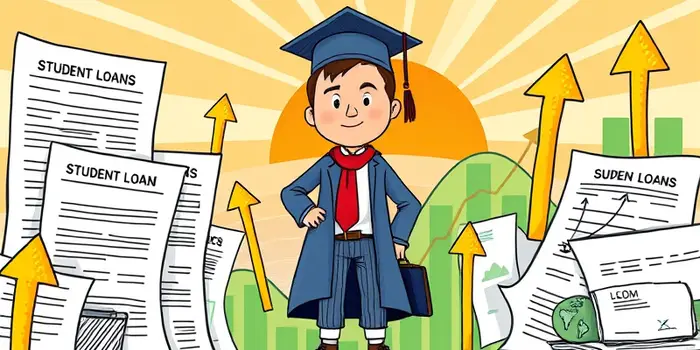Nearly 44 million Americans carry student loan debt, often at high interest rates that can feel overwhelming.
Refinancing offers a path to reduce rates, adjust terms, and reclaim financial freedom.
Understanding Student Loan Refinancing
Student loan refinancing means replacing one or more existing loans with a single new loan from a private lender. This process can involve both federal and private debts, with the new lender paying off previous balances. Refinancing is distinct from federal consolidation, as it often focuses on securing a more favorable rate or term rather than maintaining federal protections. Borrowers who qualify can enjoy steady payments and simplified statements. When done at the right time, refinancing is often strategic financial decision for borrowers seeking lower long-term costs and greater predictability.
However, you should weigh the benefits of lower rates against the loss of federal perks such as income-driven repayment and potential forgiveness programs.
Assessing Your Current Loan Portfolio
Before you explore new options, gather key details on each loan. Identify the lender, balance, interest rate, monthly payment, and remaining term for all federal and private loans. Understanding your debt structure forms the backbone of an effective refinancing plan. Use online calculators to model different scenarios, including shorter terms that may raise your monthly payment but reduce overall interest. If you juggle multiple servicers and payment dates, a refinance can simplify finances by consolidating everything into a single monthly obligation.
Deciding If Refinancing Is Right for You
While a lower interest rate can offer immediate relief, refinancing is not universally beneficial. You may lose access to federal benefits like deferment, forbearance, and forgiveness. Evaluate personal factors such as job stability, career trajectory, and the likelihood of qualifying for public service forgiveness. In many cases, you can potentially save thousands over time by securing a competitive rate, but only if you commit to consistent repayments.
- Check federal forgiveness eligibility and income-driven repayment plans
- Compare current rates and projected savings across different scenarios
- Consider long-term financial goals, such as homebuying or retirement planning
Researching and Comparing Lenders
A thorough lender comparison is critical. Look beyond headline rates and examine origination fees, late fees, and borrower protections including death or disability discharge. Use pre-qualification tools to obtain soft credit checks, which won’t affect your score. Read customer reviews to gauge responsiveness and support quality. By comparing multiple options, you can streamline multiple loans into one and simplify payments under a single interest rate and repayment plan.
Keep an eye out for features such as autopay discounts and the flexibility to switch repayment models if needed.
Eligibility and Application Requirements
Most private lenders require a credit score of at least 650 to 670, proof of steady income or employment offer, and a minimum loan balance, typically $5,000. Borrowers who did not complete a degree may face higher rates or stricter requirements, though some new lenders now accept incomplete credits. If your credit profile is thin, a trusted cosigner can improve your chances of approval and a lower rate.
Prepare essential documents: recent pay stubs, tax returns, ID, and current loan statements. Ensuring your financial records are up to date speeds up processing and reduces the risk of delays.
Interest Rates and Repayment Terms
Interest rates can be fixed or variable. Fixed rates remain constant for the life of the loan, while variable rates may start lower but fluctuate with market conditions. Most lenders offer terms ranging from five to twenty years. Shorter terms yield higher monthly payments but limit total interest paid, whereas longer terms lower monthly obligations at the cost of greater overall interest.
Whether you choose fixed or variable, make sure to tailor repayment term to budget and account for future rate shifts if you pick a variable option.
Benefits and Drawbacks of Refinancing
Refinancing presents clear advantages: a lower interest rate can accelerate principal reduction and reduce total interest paid. One payment simplifies management, and you can adjust terms to fit changing budgets. Conversely, you must consider potential downsides: refinancing federal loans with a private lender means you’ll weigh savings against lost flexibility, and you might pay more interest if you extend the term too long. Always balance immediate savings against long-term flexibility.
One of the biggest advantages is that you can maintain greater control over finances through consistent payments and transparent repayment schedules. Yet, if you anticipate relying on federal deferment or income-driven plans, refinancing may not align with your goals.
A Practical Checklist for Borrowers
- Review original loan terms and federal benefits you may forfeit
- Check credit reports, dispute errors, and improve score before applying
- Shop rates with at least three lenders and compare fee structures
- Gather application materials: income proof, ID, and loan statements
- Calculate monthly payment options using online refinance calculators
- Ensure refinancing aligns with short- and long-term financial goals
Example Savings Scenario
Consider a borrower with $40,000 in student loans at a 7% rate. Refinancing at 5% over ten years could lower the monthly payment by $66 and save over $4,000 in interest. Extending to a twenty-year term might cut the payment by $102 per month but increase total interest paid by $2,000. Using personalized calculator tools lets you dial in a term that fits both budget and debt reduction goals.
By regularly reviewing your budget and loan statements, you can ensure you stay on track, adjust autopay, and prevent late fees.
Conclusion: Taking Control of Your Financial Future
Refinancing your student loans is more than a financial transaction; it’s an opportunity to reshape your future. With thoughtful planning, careful lender selection, and a clear understanding of trade-offs, you can reduce stress, shave years off your repayment timeline, and save significant money. Whether you aim to buy a home, start a family, or build retirement savings, a smarter loan can be a cornerstone of your strategy.
Start by assessing your situation today. Explore options, compare offers, and choose the path that empowers you to meet your ambitions with confidence. Your debt journey can evolve into a story of resilience, discipline, and financial empowerment.
References
- https://www.ucu.org/blog/student-loans-refinancing-guide
- https://www.nerdwallet.com/article/loans/student-loans/how-to-refinance-student-loans
- https://brightbridge.studentchoice.org/student-loan-refinance-what-to-know-for-2025/
- https://educationdata.org/student-loan-refinancing
- https://www.lendingtree.com/student/refinance/
- https://www.collegeave.com/articles/how-to-refinance-student-loans/
- https://www.earnest.com/blog/how-to-refinance-student-loans
- https://www.bankrate.com/loans/student-loans/how-to-refinance-student-loans/










